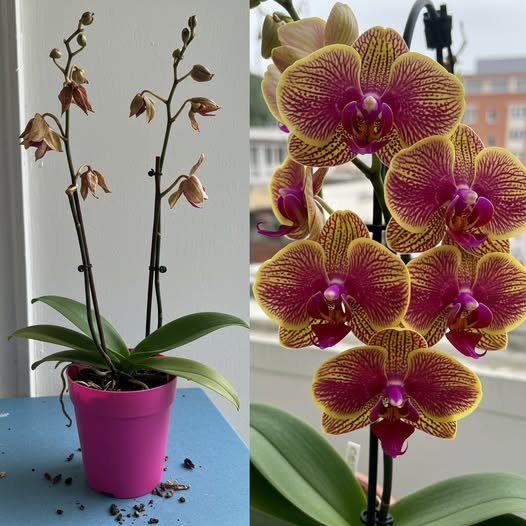3. Proper Watering
Watering is crucial to the health of your orchid. In general, it’s better to water less than more, as overwatering can damage the roots. A good approach is to feel the substrate: if it’s dry to the touch, it’s time to water. Make sure water runs out of the drainage holes. During the growing season, which is typically spring and summer, you may need to water once a week. During the winter, reduce the frequency to every two weeks.
4. Fertilization
To get your orchid to bloom again, it’s recommended to fertilize the plant during the growing season. Use a specific orchid fertilizer, diluted at half the recommended dosage, every two weeks. During the dormant period (fall and winter), you can reduce or even stop fertilizing. This will help give the plant a rest and prepare it for its next blooming cycle.
5. Pruning and Removing Wilted Flowers
After your orchids finish their blooming period, it’s important to prune the flower stalks. Trim the stalk just above a node or bud, which is usually near the base of the plant. This can stimulate the growth of new flower stalks. Don’t be discouraged if you see the flowers dropping; it’s part of the plant’s natural life cycle. Also, remove any wilted or yellowing leaves to keep the plant healthy.
6. Attention to Pests and Diseases
Orchids can be susceptible to some pests, such as aphids and mealybugs. Regularly inspect the leaves and substrate for any signs of infestation. If you find pests, you can use homemade methods such as a mild soapy water solution or specific insecticides. It’s also advisable to avoid overhead irrigation, as this can promote the growth of fungus.
7. Provide Humidity
Humidity is a key factor in orchid care. These plants typically require humid environments, so it’s advisable to increase the humidity around the plant. You can do this by placing the pot on a saucer of stones and water or using a humidifier. Mist the leaves with water is also helpful, but be sure to do this early in the day to allow the leaves to dry before nightfall.
Conclusion
With these tips and care instructions, you can keep your orchids healthy and vibrant. Make sure you provide the right environment, the right amount of light and water, and don’t forget to fertilize them during their growing season. If you follow these steps, your orchid will most likely bloom again, filling your home with beauty and color once again. Don’t lose hope if you see your flowers wilting; with the right care and attention, you can revive this beautiful plant.
